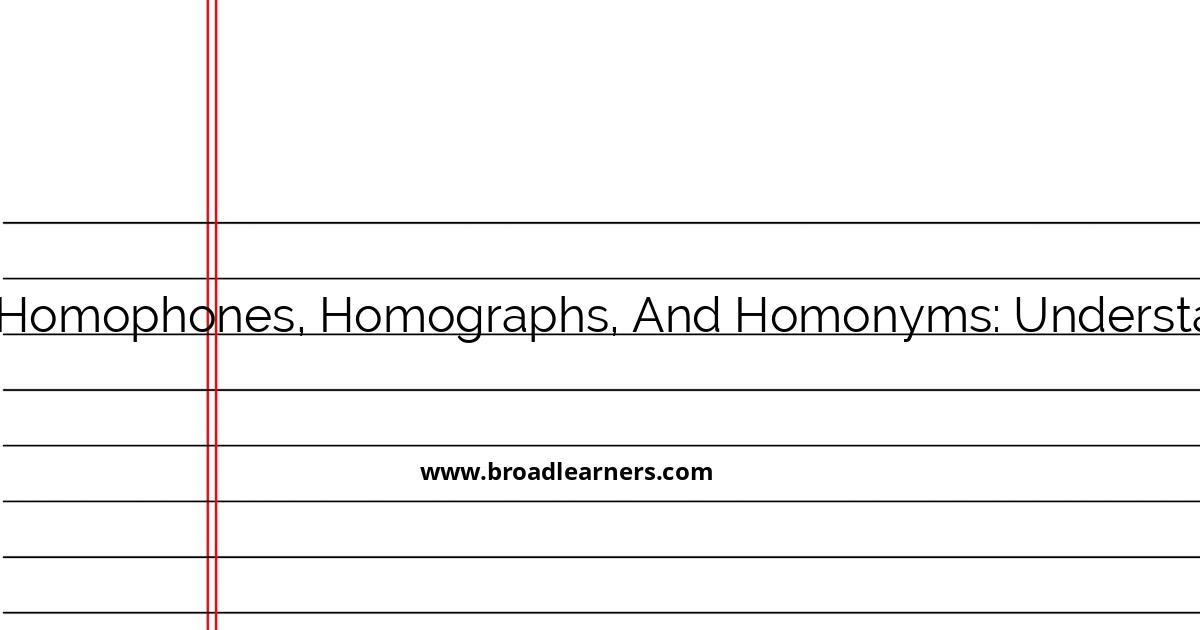English grammar can often be perplexing due to the nuances present within the language. It includes words that sound alike or are spelled alike but have different meanings, causing confusion among learners. The terms homophones, homographs, and homonyms are frequently misunderstood. Let's delve into these concepts to clarify their distinctions:
1. Homophones
- Definition:
- Homophones are words that have the same pronunciation but differ in meaning, spelling, or both.
Homophones can be particularly tricky, as they sound identical, which can lead to misunderstandings in spoken language yet are usually distinct in written form.
Examples:
- Pair and Pear: 'Pair' refers to two items considered together, while 'Pear' is a type of fruit.
- Two, Too, and To: All three sound the same but have different meanings. 'Two' is a number, 'Too' means also or excessively, and 'To' is a preposition or part of an infinitive verb.
The student ate a pear during the meeting, while the teacher discussed a pair of solutions.
He wanted to bring two friends too to the party.
2. Homographs
- Definition:
- Homographs are words that are spelled the same but differ in meaning or pronunciation.
Homographs can either sound the same or different, unlike homophones. Context often dictates their pronunciation and meaning.
Examples:
- Lead (pronounced /lɛd/) and Lead (pronounced /liːd/):
- Tear(noun) and Tear(verb):
'Lead' (/lɛd/) is a type of metal, whereas 'Lead' (/liːd/) means to guide or direct. Correct pronunciation is determined by the sentence context.
Example 1: The pipes are made of lead (metal).
Example 2: She will lead the team to victory.
As a noun, 'tear' refers to a drop of saline fluid from the eye, while as a verb, it means to rip or crack something.
Example 1: Her tears fell silently as she read the letter.
Example 2: Be careful not to tear the paper.
3. Homonyms
- Definition:
- Homonyms can refer to both homophones and homographs, meaning they can either sound the same, be spelled the same, or both while having different meanings.
Often, the term 'homonym' is used as an umbrella term encompassing both homophones and homographs.
Examples:
- Bark (Tree) and Bark (Dog):
- Bat (an implement for hitting) and Bat (a flying mammal):
The word 'bark' is spelled and pronounced the same but varies in meaning.
Example 1: The old oak tree has a rough bark.
Example 2: The dog began to bark loudly at the mailman.
Another classic homonym example where the words are spelled and pronounced the same yet carry different meanings.
Example 1: He swung the bat and hit a home run.
Example 2: At dusk, bats start flying around in search of food.
Understanding these distinctions will enhance your grasp of English grammar and improve your communication skills significantly, whether in writing or speech. Being aware of homophones, homographs, and homonyms allows for a more nuanced understanding of language, which is crucial in avoiding misunderstandings.

Did I miss anything? Respond below